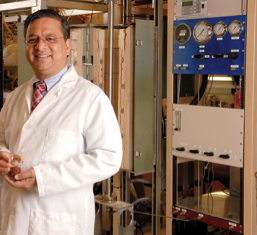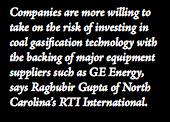Back Issues
  New energy role for King Coal With the rising cost of oil and gas, producing Synthesis Gas (Syngas) from coal-which has both financial and environmental benefits-is getting a great deal more attention, notably from power plants. By Tony Kryzanowski About a dozen new power plants designed to use fuel gas derived from coal as their energy source are currently proceeding through the licensing, design, and engineering phase of construction in the United States, and are projected to go into service between 2009 and 2012. In June 2004, GE Energy acquired the assets of Chevron Texaco's gasification technology business and is offering its customers a turnkey power generation system using coal-derived gas as the energy feedstock, along with performance guarantees. More than 65 commercial gasification facilities using GE technology are in operation or advanced development stages. ConocoPhillips has acquired patents and intellectual property associated with Global Energy Inc.'s E-Gas technology for gasification, also aiming to provide systems and equipment using coal-derived gas to the power generation industry. These indicators show the increasing interest in the use of fuel gas generated from coal as a cheaper--and environmentally acceptable--replacement for oil and natural gas among high energy users like power plants and fertilizer manufacturers these days. That's because of the historically record high prices that companies now have to pay for conventional energy sources like oil and natural gas. What's further appealing is that the United States has over a 250 year supply of known coal reserves based on current consumption of about one billion tons per year. The technology now exists to economically convert coal from a solid to a fuel gas through a process called gasification, as well as to clean its impurities. Support from big name companies like GE Energy and ConocoPhillips is also making coal more attractive to industry. Gasification is a chemical process in which finely-pulverized coal is fed into a pressurized vessel containing controlled amounts of oxygen and steam. The heat and pressure break apart the chemical bonds in the coal and form a synthesis gas, or "syngas". The ability to convert coal from a solid to gaseous form has been known for over 100 years, with syngas often used as energy for streetlights in places like London, England. It has grown in popularity for industrial use over the past 40 years, and interest in syngas use in power generation has grown significantly over the past 10 years, driven largely by environmental concerns regarding the pollutants generated by the burning of coal to produce power. Commercial use of syngas derived from coal gasification to generate power has been in steady development. A power generating facility located in Polk County, Florida and owned by the Tampa Electric Company (TECO), which uses state-of-the-art integrated gasification combined cycle (IGCC) technology, has been operating since 1996. This 260-megawatt power plant has expanded twice since 1996 to bring three turbines on stream, although only its first turbine is equipped to burn syngas. That's because the two remaining units are only used during peak operating hours. The power plant now supplies power to about 75,000 homes. "We run on syngas most of the time," says Mark Hornick, general manager for the Polk Power Station. "We run Polk Unit One before any other unit on our system because it is the lowest cost to operate." TECO, as the plant owner/operator, Texaco, as the technology licenser, and Bechtel, as the architect/e ngineer, were awarded $120 million from the United States Department of Energy in 1994 for a project to develop clean coal technology. The result of the collaboration was the TECO Polk Power Plant. That was at a time when the price for natural gas was still selling at between $3 and $4 per million British Thermal Units (BTUs). This past winter, it was up as high as $15 per million BTUs, having since settled back since then.  Hornick says given the high cost of oil and natural gas, interest in coal gasification technology has definitely increased lately. "We've seen a big increase in interest because of the sustained high price of natural gas in North America," he says. "We've had over 4,000 visitors through our site since we've been in operation. We understand the technology and are exposed to a lot of folks who are interested in coal gasification for its market potential." The Polk Power Plant uses a combination of petroleum coke, which is a byproduct of oil refining, and coal in its gasification process. TECO has found that coke is a low cost feedstock that responds well to gasification. A specific recipe of coal to petroleum coke delivers the quantity and quality of syngas that the power plant requires. Raghubir Gupta, senior director at research organization RTI International in North Carolina, says more companies, specifically in the power generation industry, are now much more willing to take the risk of investing in coal gasification technology with the backing of big companies like GE Energy. RTI's involvement in coal gasification has been in the development of technology to remove impurities such as sulfur, chlorine, ammonia and metals. It already has commercial technology to reduce sulfur emissions from syngas using regenerable sorbents. It is currently working on even deeper cleaning processes that would remove additional sulfur, nitrogen, chlorine, and heavy metals such as mercury and arsenic, to achieve near zero emissions from these coal plants. Gupta says that from a technical standpoint, it is much easier to clean syngas derived from coal gasification than to clean emissions from burning solid coal. The byproduct from coal gasification is a vitrified ash that Gupta say does not contain harmful toxins and is commonly used in road construction. The process does need to be adjusted to take coal with different chemical characteristics into account. For example, eastern U.S. coal tends to be more reactive but have higher sulfur content, whereas western U.S. coal tends to be the opposite. Also, low ash coals tend to offer the best bang for the buck in terms of the coal gasification process. Another reason why the potential for clean syngas derived from coal in power generation has captured the attention of that industry is because of the strict emission controls placed upon it by the Environmental Protection Agency (EPA). The environmental problems associated with acid rain, largely blamed on air pollutants in the generation of power using coal, is well documented. So the industry has had to adapt. Potentially new regulations concerning the control of gases that contribute to global warming has ignited a new sense of urgency among greenhouse gas generating industries to investigate the use of cleaner burning fuels. Purified syngas derived from coal gasification could meet their needs in future. "Everyone is very aware of the carbon dioxide situation," says Gupta. "If any carbon dioxide emission regulations come in, industry wants to be prepared for them." Hornick agrees that industry is looking for ways to be prepared for legislation aimed at controlling greenhouse gases. "Longer term, gasification has got a pretty clear advantage in terms of the ability it gives to the plant operator to remove carbon dioxide and sequester it," he says. "IGCC is much more readily adapted to controlling carbon dioxide." Gupta says that burning 100 BTUs of coal produces about 35 BTUs of power in a coal combustion system, while burning 100 BTUs of coal in a gasification system could deliver about 45 BTUs of power. However, Hornick points out that it is still 10 to 20 percent more expensive to build an IGCC plant than a traditional pulverized coal unit. "That extra cost is made up for in superior environmental performance," says Hornick, "and the ability to combine coal with petroleum coke, which is a lower cost fuel. You are paying a little more up front, but the cost of using syngas is lower over the long term." Producing syngas from coal is cost competitive based on the prices for oil and natural gas. In fact, although prices have trended lower lately, the high price of natural gas has forced about 75 percent of new power generating plants built in the 1990s using that fuel as a feedstock to close down. RTI says that the raw material cost for coal is between $1 and $2 per million BTUs, $8 to $9 for natural gas per million BTUs, $13 to $15 for gasoline or diesel per million BTUs, and roughly $20 to use electricity to generate a million BTUs. When the cost of gasification and purifying coal to produce commercial syngas is factored in, syngas from coal costs between $4 and $5 per million BTUs.  Gupta says that a number of power plants that closed due to the high cost of natural gas are now looking seriously at using syngas derived from coal gasification as a cheaper alternative feedstock as one way to justify reopening their plants. He adds that a number of fertilizer plants that closed due to the high cost of natural gas are also looking as coal-derived syngas as a more affordable alternative. The primary risk that companies face with an investment in coal gasification is in the infrastructure. The danger is that the price of natural gas could once again fall to lower levels, putting syngas from coal at a competitive disadvantage. However, North American natural gas reserves are falling and construction projects like the Alaska and Mackenzie Valley natural gas pipelines to deliver gas from the far north to southern markets are still years away. Syngas has a variety of other uses besides energy. It can, in fact, be used as a building block to manufacture any product where other hydrocarbons are commonly used. This includes diesel, jet fuel, methanol, ethanol, fertilizer, and plastics. "It is possible to produce extremely good quality diesel fuel from coal on a cost comparable basis when crude oil is about $40 a barrel," says Gupta. "If oil prices stay around $60 per barrel, it makes a whole lot more sense to produce diesel from coal than from crude."   July/August 2006
|








